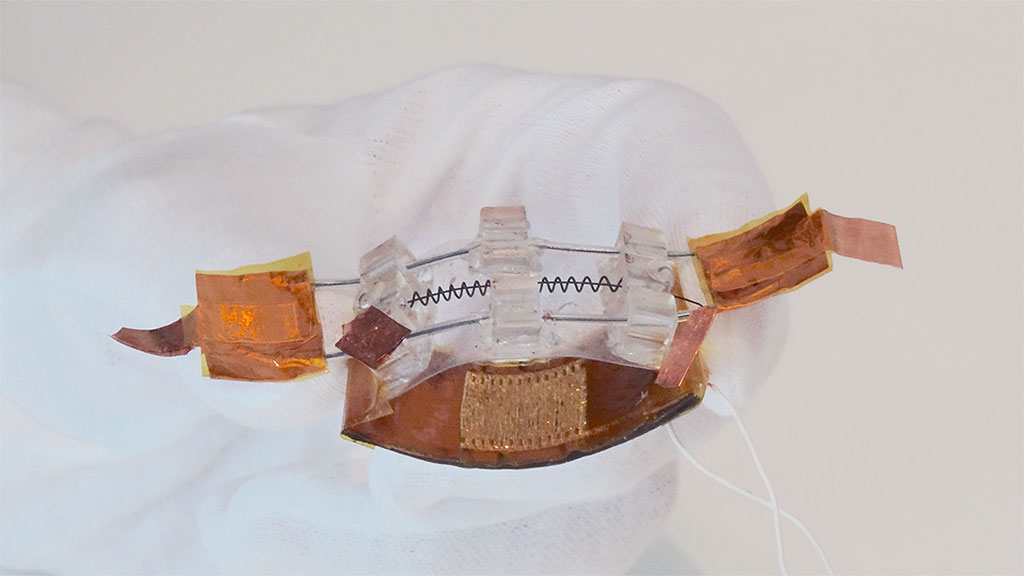Unified Bladder Actuation System Aids Efficient Voiding
|
By HospiMedica International staff writers Posted on 20 May 2020 |

Image: An integrated sensing-actuation device controls bladder volume (Photo courtesy of NUS)
An integrated sensing-actuation device can improve the performance of underactive bladders, according to a new study.
Developed by researchers at the National University of Singapore (NUS; Singapore), the University of Tokyo (Japan), and other institutions, the novel bladder system integrates a soft, thin capacitive sensor with a shape memory alloy (SMA) based actuator in order to create a high-performance, closed-loop configuration capable of continuous bladder volume detection and voiding. The SMA actuator contains a spring element that keeps a sensor in contact with the surface of the bladder at all times for precise volume detection.
In animal studies, the system attained a highly desirable voiding target of 71-100% of a rat’s bladder with a volume sensitivity of 0.7 μF/liter. The high sensitivity of the sensor during both the storage and voiding phases is the result of its wrinkled structure, which operates similar to bladder muscle receptors with dual functionality of normal and stretching force sensation. For comparison, current implantable treatment options can only sense the fullness of the bladder, and only empty it up to 43%. The study was published on May 1, 2020, in Science Advances.
“Our solution integrates sensing-actuation elements that are bladder compatible but do not interfere with one another, achieving real-time bladder management,” said lead author Faezeh Arab Hassani, PhD, of NUS. “The bladder system can be adjusted to the user's bladder size to ensure optimal operation. The ideal scenario would be to integrate the device with a mobile application, which can retrieve and process the sensor data to allow the user to trigger voiding at will.”
Bladder volume measurement is a well-established metric used in the diagnosis and treatment of a wide range of medical conditions. It is a critical component of comprehensive catheter-associated urinary tract infections (CAUTI) prevention programs, an area of intense focus for hospitals as a result of U.S. Medicare penalties for hospitals with high rates.
Related Links:
National University of Singapore
University of Tokyo
Developed by researchers at the National University of Singapore (NUS; Singapore), the University of Tokyo (Japan), and other institutions, the novel bladder system integrates a soft, thin capacitive sensor with a shape memory alloy (SMA) based actuator in order to create a high-performance, closed-loop configuration capable of continuous bladder volume detection and voiding. The SMA actuator contains a spring element that keeps a sensor in contact with the surface of the bladder at all times for precise volume detection.
In animal studies, the system attained a highly desirable voiding target of 71-100% of a rat’s bladder with a volume sensitivity of 0.7 μF/liter. The high sensitivity of the sensor during both the storage and voiding phases is the result of its wrinkled structure, which operates similar to bladder muscle receptors with dual functionality of normal and stretching force sensation. For comparison, current implantable treatment options can only sense the fullness of the bladder, and only empty it up to 43%. The study was published on May 1, 2020, in Science Advances.
“Our solution integrates sensing-actuation elements that are bladder compatible but do not interfere with one another, achieving real-time bladder management,” said lead author Faezeh Arab Hassani, PhD, of NUS. “The bladder system can be adjusted to the user's bladder size to ensure optimal operation. The ideal scenario would be to integrate the device with a mobile application, which can retrieve and process the sensor data to allow the user to trigger voiding at will.”
Bladder volume measurement is a well-established metric used in the diagnosis and treatment of a wide range of medical conditions. It is a critical component of comprehensive catheter-associated urinary tract infections (CAUTI) prevention programs, an area of intense focus for hospitals as a result of U.S. Medicare penalties for hospitals with high rates.
Related Links:
National University of Singapore
University of Tokyo
Latest Critical Care News
- CPR Guidelines Updated for Pediatric and Neonatal Emergency Care and Resuscitation
- Ingestible Capsule Monitors Intestinal Inflammation
- Wireless Implantable Sensor Enables Continuous Endoleak Monitoring
- Pulse Oximeter Index Offers Non-Invasive Guides for Fluid Therapy
- Wearable Patch for Early Skin Cancer Detection to Reduce Unnecessary Biopsies
- 'Universal' Kidney to Match Any Blood Type
- Light-Based Technology to Measure Brain Blood Flow Could Diagnose Stroke and TBI
- AI Heart Attack Risk Assessment Tool Outperforms Existing Methods
- Smartphone Imaging System Enables Early Oral Cancer Detection
- Swallowable Pill-Sized Bioprinter Treats GI Tract Injuries

- Personalized Brain “Pacemakers” Could Help Patients with Hard-To-Treat Epilepsy
- Microscopic DNA Flower Robots to Enable Precision Medicine Delivery
- Origami Robots to Deliver Medicine Less Invasively and More Effectively
- Improved Cough-Detection Technology Aids Health Monitoring
- AI Identifies Children in ER Likely to Develop Sepsis Within 48 Hours
- New Radiofrequency Therapy Slows Glioblastoma Growth
Channels
Surgical Techniques
view channel
Robotic Assistant Delivers Ultra-Precision Injections with Rapid Setup Times
Age-related macular degeneration (AMD) is a leading cause of blindness worldwide, affecting nearly 200 million people, a figure expected to rise to 280 million by 2040. Current treatment involves doctors... Read more
Minimally Invasive Endoscopic Surgery Improves Severe Stroke Outcomes
Intracerebral hemorrhage, a type of stroke caused by bleeding deep within the brain, remains one of the most challenging neurological emergencies to treat. Accounting for about 15% of all strokes, it carries... Read morePatient Care
view channel
Revolutionary Automatic IV-Line Flushing Device to Enhance Infusion Care
More than 80% of in-hospital patients receive intravenous (IV) therapy. Every dose of IV medicine delivered in a small volume (<250 mL) infusion bag should be followed by subsequent flushing to ensure... Read more
VR Training Tool Combats Contamination of Portable Medical Equipment
Healthcare-associated infections (HAIs) impact one in every 31 patients, cause nearly 100,000 deaths each year, and cost USD 28.4 billion in direct medical expenses. Notably, up to 75% of these infections... Read more
Portable Biosensor Platform to Reduce Hospital-Acquired Infections
Approximately 4 million patients in the European Union acquire healthcare-associated infections (HAIs) or nosocomial infections each year, with around 37,000 deaths directly resulting from these infections,... Read moreFirst-Of-Its-Kind Portable Germicidal Light Technology Disinfects High-Touch Clinical Surfaces in Seconds
Reducing healthcare-acquired infections (HAIs) remains a pressing issue within global healthcare systems. In the United States alone, 1.7 million patients contract HAIs annually, leading to approximately... Read moreHealth IT
view channel
Printable Molecule-Selective Nanoparticles Enable Mass Production of Wearable Biosensors
The future of medicine is likely to focus on the personalization of healthcare—understanding exactly what an individual requires and delivering the appropriate combination of nutrients, metabolites, and... Read moreBusiness
view channel
Philips and Masimo Partner to Advance Patient Monitoring Measurement Technologies
Royal Philips (Amsterdam, Netherlands) and Masimo (Irvine, California, USA) have renewed their multi-year strategic collaboration, combining Philips’ expertise in patient monitoring with Masimo’s noninvasive... Read more
B. Braun Acquires Digital Microsurgery Company True Digital Surgery
The high-end microsurgery market in neurosurgery, spine, and ENT is undergoing a significant transformation. Traditional analog microscopes are giving way to digital exoscopes, which provide improved visualization,... Read more
CMEF 2025 to Promote Holistic and High-Quality Development of Medical and Health Industry
The 92nd China International Medical Equipment Fair (CMEF 2025) Autumn Exhibition is scheduled to be held from September 26 to 29 at the China Import and Export Fair Complex (Canton Fair Complex) in Guangzhou.... Read more














